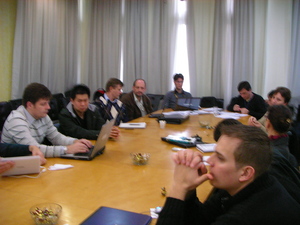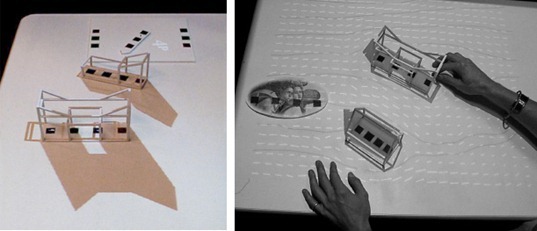The traditional free meeting model for participation where supposedly every stakeholder can talk about their concerns often doesn’t satisfy the participants, for many reasons. The consensus is built up on participant’s fatigue; when one give up discussing a project stake not because she start to agree, but because she’s too tired to discuss it. This often happens after circular discussions about abstract things that each participant conceptualizes differently.

The above image was taken two years ago, when I was involved on the website redesign of the University where I got my Master degree, the Technological University of Paraná. The previous version were designed with no participation at all and the University administration thought this was the cause of it’s failure to meet user needs. That time, they really wanted participation, so they gather together about 20 people to decide what to do in every step. Because many of the participants came from distant cities, they concentrated the participation on meetings that lasted for no less than 8 hours! The first meeting was not really being productive until someone opened the previous website in a projector and people could finally understand each other.
Generally, the abstraction level decreases along the project, as decisions are made. The participation runs smoother when a project has concrete props to discuss on and that’s why many projects start to open for broad participation only after it has some high level decisions made up. Some limitations arise by this strategy, since many important stakeholders were prevented from giving insights because of the abstraction gap. This is a major contradiction for fostering social innovation.
One of the goals of my PhD Research is to develop some tools for bridging the abstraction gap within hospital building projects. Tools that help participants create or modify concrete representations of abstract concepts like space use, light conditions, climate control, and workflow. It’s expected that these tools have collaborative features for enabling the participation through their usage, not only in meetings, but in non-predicted opportunities, increasing the possibilities of spontaneous innovation.
I didn’t have seen many tools like that, but I’m sure there should be something similar out there. That’s what I’ll start to look for now. By the way, I remember seeing something similar at John Underkoffler’s TED talk. He showed a projection table where people could arrange small buildings props and see it’s impact into air flow, lightning, and shadows simulation.
Later on he used the same tangible interface for urban planning, extending it’s feature.




[…] how to improve them for better efficiency, learnability, and extensibility. Eventually, he design tools that embed or support those process. Those tools help domain experts access or create networks that […]
[…] if we make bridges across what they know to design and what they don’t know like, for instance, a collaborative tool? A DIY manual? A Knowledge Base? A metadesign […]
[…] research goal is to develop tools for this kind of collaboration, but I’ll explore using simulations. The work of Sanders is important to me to remember that […]